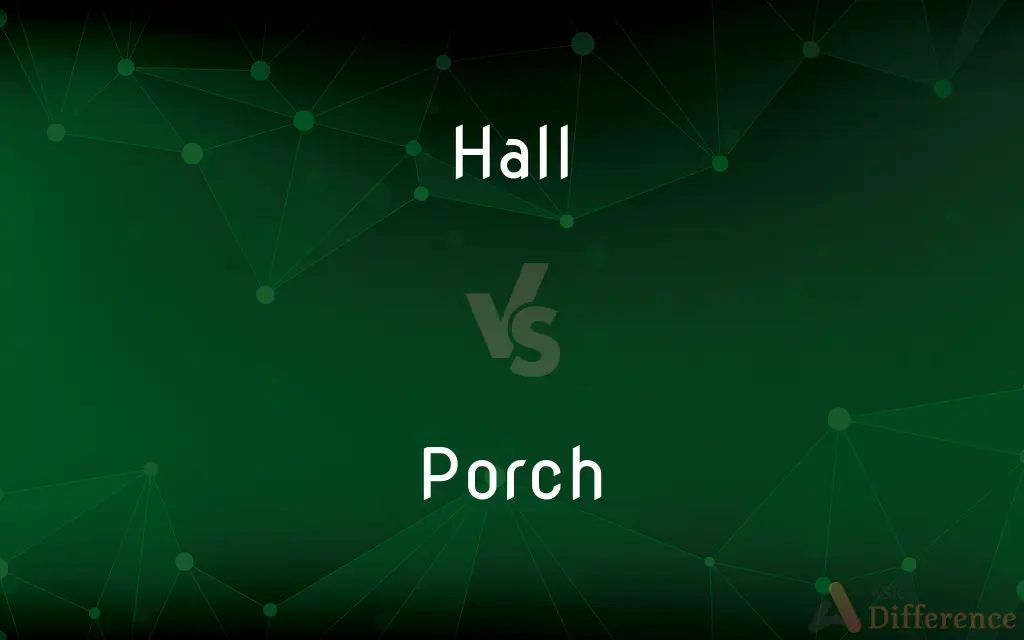Hall vs. Porch — What's the Difference?
By Maham Liaqat & Fiza Rafique — Updated on March 28, 2024
A hall is an interior corridor or room serving as an entryway within a building, while a porch is an exterior structure attached to the entrance of a building, offering transitional space from outside to inside.

Difference Between Hall and Porch
Table of Contents
ADVERTISEMENT
Key Differences
A hall, in architectural terms, typically refers to a large room or corridor inside a building that provides access to various rooms. It's often found at the entrance, where it can serve as a reception area or lobby, especially in public buildings or large residences. On the other hand, a porch is an outdoor structure attached to the entrance of a building, covered by a roof and sometimes enclosed by walls, screens, or windows. Porches serve multiple purposes: they can protect the entrance from the weather, provide a comfortable outdoor living space, and enhance the building's aesthetic appeal.
While halls are primarily about interior navigation and space organization, porches offer a blend of functionality and aesthetics on a building's exterior. Halls manage the distribution of indoor traffic and may include features like coat closets or staircases, emphasizing utility and access. Porches, however, extend the living space outdoors, creating a seamless transition between the interior and the exterior environment, and are valued for their ability to offer shelter, leisure, and a welcoming entrance.
Both halls and porches contribute to the overall design and usability of buildings but in different ways. Halls enhance the interior's functionality and flow, serving as critical points of transition within the space. Porches, conversely, accentuate a building's entrance, offering outdoor enjoyment and practical benefits like weather protection and increased curb appeal.
The distinction between halls and porches reflects their respective roles in architecture: one as an essential component of the interior layout and the other as a versatile feature of the exterior facade. Despite their differences, both are pivotal in defining the character and functionality of a building, providing spaces that facilitate movement, welcome, and interaction.
Comparison Chart
Location
Interior of a building.
Exterior of a building, attached to the entrance.
ADVERTISEMENT
Function
Provides access to various rooms, serves as a reception area.
Offers transitional space from outside to inside, serves for relaxation.
Design Influence
Influences interior flow and function.
Enhances exterior aesthetic and usability.
Features
May include coat closets, staircases, and artwork.
Often covered by a roof, may include screens or windows.
Primary Purpose
Navigation and organization within a building.
Protection from weather, outdoor living space.
Usage
Seen in both public buildings and residences.
Common in residences, varies by climate and culture.
Architectural Focus
Interior design and layout.
Building's facade and entrance appeal.
Social Aspect
Less prominent; more functional.
Encourages social interaction and outdoor leisure.
Compare with Definitions
Hall
A wide corridor or room in a building serving as an entryway or passage.
The grand hall led to a series of elaborately decorated rooms.
Porch
A covered shelter projecting in front of the entrance of a building.
They sat on the porch, enjoying the cool evening breeze.
Hall
Often the first interior space encountered upon entering a building.
They hung their coats in the hall before entering the living room.
Porch
Enhances the aesthetic appeal and functionality of a building's entrance.
The house's porch, adorned with hanging plants, offered a warm welcome.
Hall
Can be designed to be grand and welcoming in public buildings.
The hotel's main hall was adorned with a magnificent chandelier.
Porch
Offers a space for relaxation and social interaction outside the house.
Neighbors often gathered on the front porch to chat in the evenings.
Hall
Plays a crucial role in interior navigation and space distribution.
The hall connected the various parts of the house seamlessly.
Porch
Serves as a transitional space between the exterior and the interior.
The porch provided a cozy spot to remove muddy boots before entering.
Hall
May serve specific functions like a reception area in large buildings.
The visitors were greeted in the spacious hall of the corporation's headquarters.
Porch
Can be enclosed or open, depending on the design and purpose.
The screened porch was a perfect place for summer dinners outdoors.
Hall
In architecture, a hall is a relatively large space enclosed by a roof and walls. In the Iron Age and early Middle Ages in northern Europe, a mead hall was where a lord and his retainers ate and also slept.
Porch
A porch (from Old French porche, from Latin porticus "colonnade", from porta "passage") is a room or gallery located in front of an entrance of a building. A porch is placed in front of the facade of a building it commands, and forms a low front.
Hall
A corridor or passageway in a building.
Porch
A covered platform, usually having a separate roof, at an entrance to a building.
Hall
A large entrance room or vestibule in a building; a lobby.
Porch
An open or enclosed gallery or room attached to the outside of a building; a veranda.
Hall
A building for public gatherings or entertainments.
Porch
(Obsolete) A portico or covered walk.
Hall
The large room in which such events are held.
Porch
(architectural element) A covered entrance to a building, whether taken from the interior, and forming a sort of vestibule within the main wall, or projecting without and with a separate roof. A porch often has chair(s), table(s) and swings.
Hall
A building used for the gatherings and social activities of a church, fraternal order, or other organization.
Porch
A portico; a covered walk.
Hall
A building belonging to a school, college, or university that provides classroom, dormitory, or dining facilities.
Porch
The platform outside the external hatch of a spacecraft.
Hall
A large room in such a building.
Porch
A covered and inclosed entrance to a building, whether taken from the interior, and forming a sort of vestibule within the main wall, or projecting without and with a separate roof. Sometimes the porch is large enough to serve as a covered walk. See also Carriage porch, under Carriage, and Loggia.
The graceless Helen in the porch I spiedOf Vesta's temple.
Hall
The group of students using such a building
The entire hall stayed up late studying.
Porch
A portico; a covered walk.
Repair to Pompey's porch, where you shall find find us.
Hall
Chiefly British A meal served in such a building.
Porch
A structure attached to the exterior of a building often forming a covered entrance
Hall
The main house on a landed estate.
Hall
The castle or house of a medieval monarch or noble.
Hall
The principal room in such a castle or house, used for dining, entertaining, and sleeping.
Hall
A corridor; a hallway.
The drinking fountain was out in the hall.
Hall
A meeting room.
The hotel had three halls for conferences, and two were in use by the convention.
Hall
A manor house (originally because a magistrate's court was held in the hall of his mansion).
The duke lived in a great hall overlooking the sea.
Hall
A building providing student accommodation at a university.
The student government hosted several social events so that students from different halls would intermingle.
Hall
The principal room of a secular medieval building.
Hall
(obsolete) Cleared passageway through a crowd, as for dancing.
Hall
A place for special professional education, or for conferring professional degrees or licences.
A Divinity Hall; Apothecaries' Hall
Hall
(India) A living room.
Hall
(Oxbridge) A college's canteen, which is often but not always coterminous with a traditional hall.
Hall
(Oxbridge slang) A meal served and eaten at a college's hall.
Hall
A building or room of considerable size and stateliness, used for public purposes; as, Westminster Hall, in London.
Hall
The chief room in a castle or manor house, and in early times the only public room, serving as the place of gathering for the lord's family with the retainers and servants, also for cooking and eating. It was often contrasted with the bower, which was the private or sleeping apartment.
Full sooty was her bower and eke her hall.
Hall
A vestibule, entrance room, etc., in the more elaborated buildings of later times.
Hall
A name given to many manor houses because the magistrate's court was held in the hall of his mansion; a chief mansion house.
Hall
A college in an English university (at Oxford, an unendowed college).
Hall
The apartment in which English university students dine in common; hence, the dinner itself; as, hall is at six o'clock.
Hall
Cleared passageway in a crowd; - formerly an exclamation.
Hall
An interior passage or corridor onto which rooms open;
The elevators were at the end of the hall
Hall
A large entrance or reception room or area
Hall
A large room for gatherings or entertainment;
Lecture hall
Pool hall
Hall
A college or university building containing living quarters for students
Hall
The large room of a manor or castle
Hall
English writer whose novel about a lesbian relationship was banned in Britain for many years (1883-1943)
Hall
United States child psychologist whose theories of child psychology strongly influenced educational psychology (1844-1924)
Hall
United States chemist who developed an economical method of producing aluminum from bauxite (1863-1914)
Hall
United States explorer who led three expeditions to the Arctic (1821-1871)
Hall
United States astronomer who discovered Phobos and Deimos (the two satellites of Mars) (1829-1907)
Hall
A large and imposing house
Hall
A large building used by a college or university for teaching or research;
Halls of learning
Hall
A large building for meetings or entertainment
Common Curiosities
Can halls be found in all types of buildings?
Yes, halls are common in many types of buildings, from residential homes to public and commercial buildings, serving as essential spaces for navigation and transition.
What is the main function of a hall?
The main function of a hall is to provide access to various rooms within a building, serving as a corridor or reception area.
How does a porch differ from a balcony?
A porch is a ground-level or slightly elevated structure at the entrance of a building, while a balcony is an elevated platform projecting from the wall of a building, usually on an upper floor.
Can a hall function as a living space?
While halls are primarily passageways, they can also be furnished to function as informal living spaces, especially in larger homes where they might serve as sitting areas or display art.
Is it common for a house to have both a hall and a porch?
Yes, many houses feature both a hall and a porch, with the porch serving as an exterior entrance space and the hall providing interior access and circulation.
Are porches only suitable for certain climates?
While porches can be adapted to various climates by enclosing them or using weather-resistant materials, they are particularly popular in regions where outdoor living is feasible year-round.
What architectural styles are known for their porches?
Styles such as Victorian, Craftsman, and Colonial are known for their distinctive porches, which serve as key architectural and social features of these homes.
How can a porch impact a home's curb appeal?
A well-designed porch can significantly enhance a home's curb appeal by adding character, providing a welcoming entrance, and offering a glimpse of the homeowner's style.
What are some common uses for a porch?
Porches can be used for relaxation, socializing, outdoor dining, and as a protective entryway for removing outerwear before entering a home.
How do modern homes incorporate halls and porches?
Modern homes often incorporate halls and porches in streamlined, functional designs, with halls facilitating flow inside the home and porches offering minimalist, practical outdoor spaces.
Share Your Discovery

Previous Comparison
Attire vs. Uniform
Next Comparison
Reading vs. ReviewAuthor Spotlight
Written by
Maham LiaqatCo-written by
Fiza RafiqueFiza Rafique is a skilled content writer at AskDifference.com, where she meticulously refines and enhances written pieces. Drawing from her vast editorial expertise, Fiza ensures clarity, accuracy, and precision in every article. Passionate about language, she continually seeks to elevate the quality of content for readers worldwide.















































